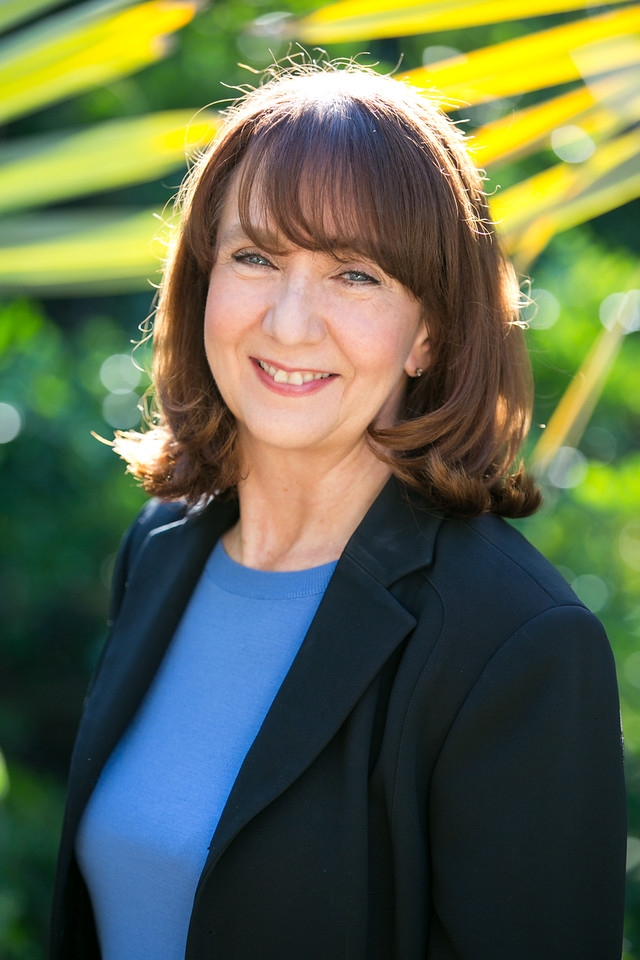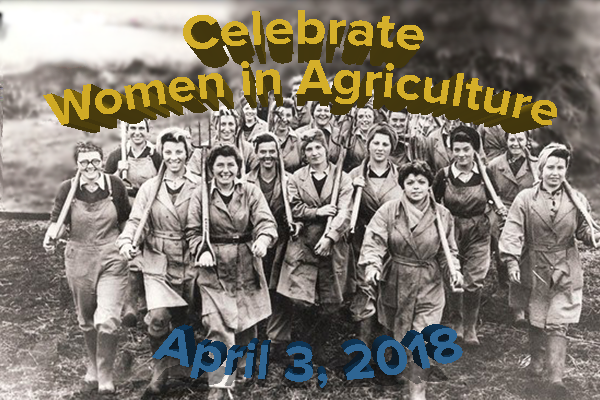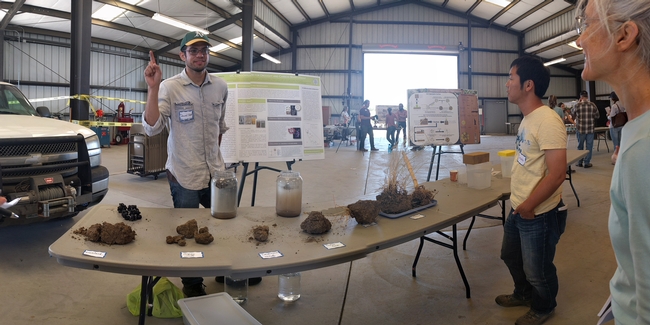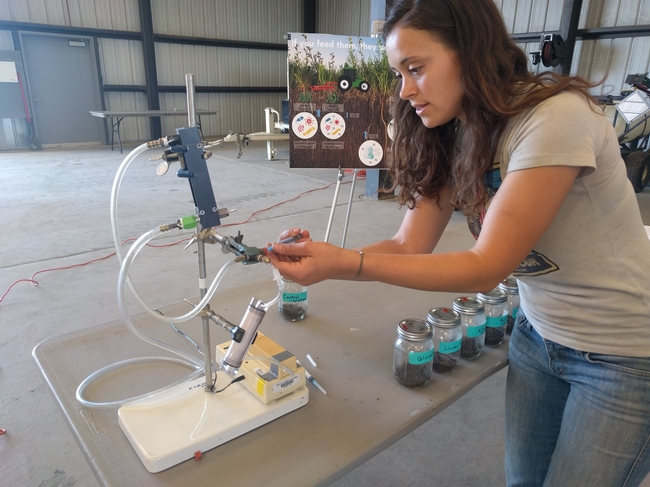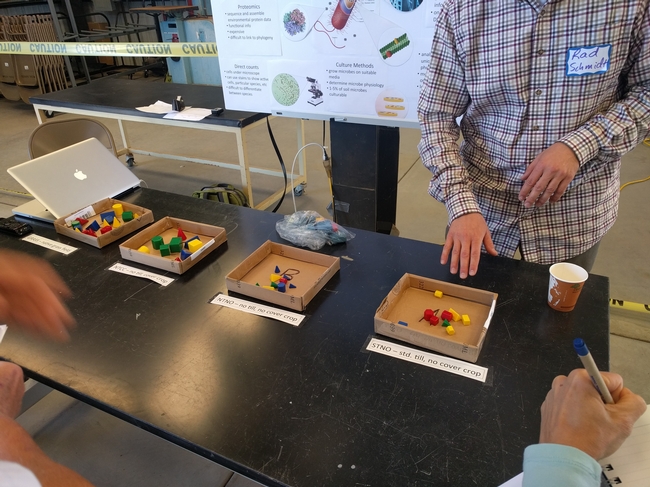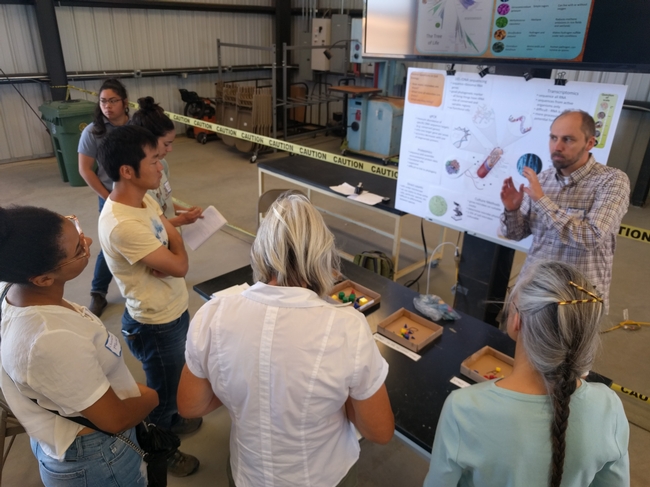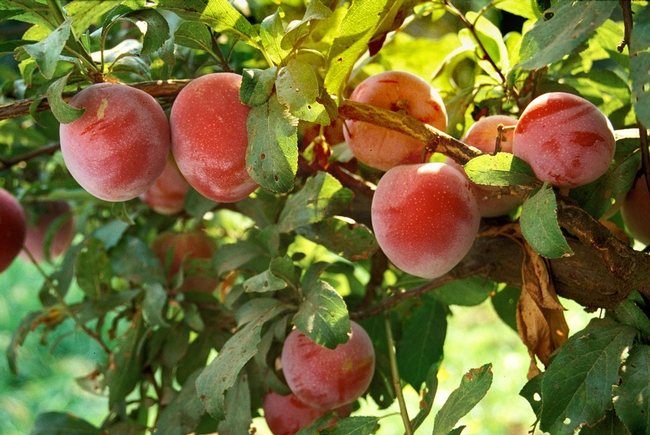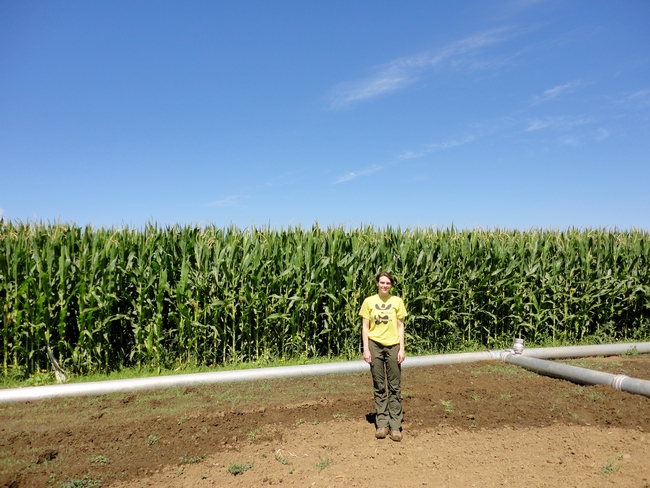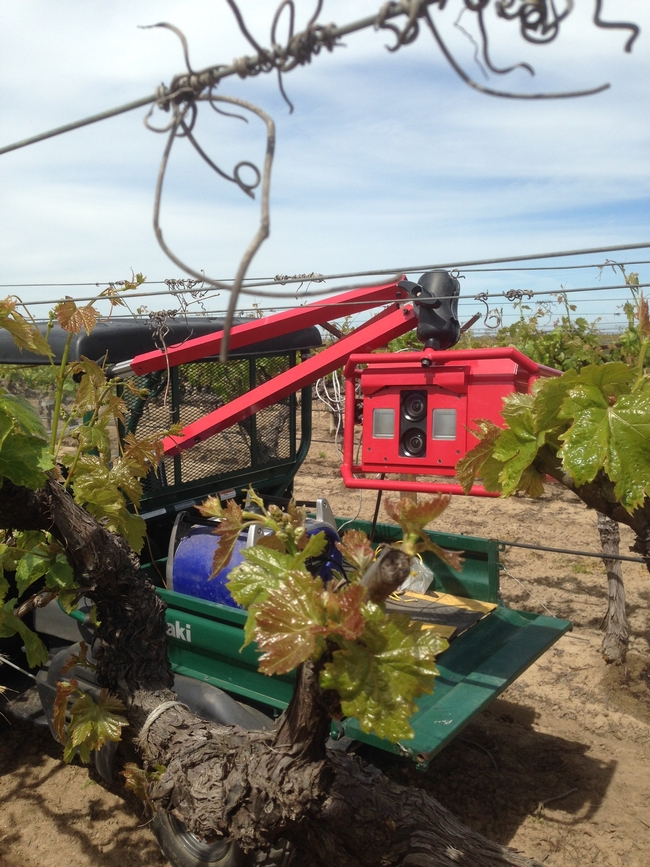Posts Tagged: sustainable
UCCE advisor Rachel Surls receives 2018 Bradford Rominger Agricultural Sustainability Leadership Award
The Agricultural Sustainability Institute at UC Davis has announced that Rachel Surls, UC Cooperative Extension sustainable food systems advisor for Los Angeles County, is this year's recipient of the Eric Bradford and Charlie Rominger Agricultural Sustainability Leadership Award.

The Bradford Rominger award, given yearly, honors individuals who exhibit the leadership, work ethic and integrity epitomized by the late Eric Bradford, a livestock geneticist who gave 50 years of service to UC Davis, and the late Charlie Rominger, a fifth-generation Yolo County farmer and land preservationist.
“In her three decade career with UCCE, Rachel has developed a strong program addressing some of our most critical issues in sustainable agriculture,” says Keith Nathaniel, the Los Angeles County Cooperative Extension director. “She does so with innovative strategies, working with all aspects of the LA community. After 30 years doing this work, she continues to be active in the community she serves.”
In Surls' career, gardening has been a tool to build science literacy for school children, to increase self-sufficiency for communities impacted by economic downturn, and to create small businesses for urban entrepreneurs. As the interest in and support for urban agriculture has grown, she has been in the heart of Los Angeles, ready to respond to the needs of the city's farmers and gardeners.
Her role at Cooperative Extension started as a job to help start school gardens in LA. “I would drive to any school that wanted me and help them dig in the gardens,” Surl said. “I could find teachers who were interested in starting gardens, but I couldn't find principals and administrators to support it.”
Early on, some counseled Surls to find an area of expertise that was more serious than community and school gardens. Despite the criticism, “I just chugged along, doing what I knew was good and what I cared about,” Surl said.
And over time, the value of these programs has become more apparent, and support for them has grown. Surls continued along, working to start community gardens at public housing facilities, and overseeing the Los Angeles County UC Master Gardener program.
In 1997, she stepped into a role as the UC Cooperative Extension county director, ensuring the success of extension efforts for all of Los Angeles County for the next 14 years.
In 2008 came the great recession, and with it an uptick in public interest in home grown food.
“We were getting more and more calls in our office on how to be more self-sufficient,” Surls said. “The economics of the time rattled people, so they were thinking more about how to grow their own food, and how to maybe make some money by selling what they grow. And people needed the support and guidance to do that.”
Surls and her partners are working to meet that need through workshops in California's largest metropolitan areas and a website of resources to help new urban farmers get a leg up on farming in the city. Surls is also a member of the leadership board for the Los Angeles Food Policy Council.
The energy around urban agriculture today is palpable. And a career path that was once not taken seriously now is.
“That has really changed in our institution and culture,” Surl said. “We're hiring people to do this work!”
Persistent and focused, Surls' work is one of the reasons that progress is happening.
Surls will receive the award at the Celebrating Women in Agriculture event in Davis April 3. The event is free and open to the public. Learn more about the event here.
Powers of microbes: UC Davis graduate students get creative to teach farmers about soil microbiology
If you grew up in the 1980s or 1990s (or were a child at heart during that era), the famous Powers of Ten film likely left an indelible mark in your mind.
The film starts with a couple lounging on a picnic blanket and zooms out to the outer reaches of the universe, then back in to peer into the microscopic world of the human body: from white blood cells to DNA, and finally down to the proton of a carbon atom.
In its short 9-minute run time, Powers of Ten manages to inflame an existential angst about the size of a single human life while at the same time connecting the viewer to the beauty of the universe and the human body.
As a high school student watching the video, it filled me with the same sense of awe that I felt the first time I heard Carl Sagan's famous quote that “we are all made of star stuff.”
Powers of Ten reminds us that looking at the world from different perspectives, from the very tiny to the immensely large, helps create a better understanding of the natural world, our place within it, and how we can impact it for good.
Had Powers of Ten returned from outer space by zooming into a piece of soil rather than a the human body, it would have explored the billions of living creatures in one handful of soil, slowly scaling down from millipedes to earthworms to ants to nematodes to protozoa, and finally down to the soil's bacteria and fungi that make up the base of the soil food web.
The video might then have looked a lot like the recent workshop at the Russell Ranch Sustainable Agriculture Facility, which served as a science fair for farmers and researchers to learn about the minuscule but powerful soil microbe.
While farmers often have a baseline knowledge about soil microbiology and its importance on the farm, “the science is evolving so quickly at this point, that it can be hard to keep up,” said attendee Margaret Lloyd, UC Cooperative Extension advisor who works with small-scale farmers in Yolo and Sacramento counties.
The workshop coupled foundational principles of soil microbiology with practical on-farm management situations, making the case for farmers to actively consider soil bacteria, fungi, and other micro organisms in their decision-making process.
Jessica Chiartas, a fourth-year graduate student in soil microbiology and one of the workshop organizers, is somewhat of a soil science evangelist.
Her hope was to help workshop attendees better understand that “soils are not just physical, chemical systems. A majority of the processes that take place underfoot are biologically driven. Soils are living and breathing bodies and much like us, they need to be fed, covered, and protected from disturbance” in order to function in the long term.
Scaling down
The scale of microbial activity in soil makes it challenging to help farmers dig into just what scientists are talking about when they talk about microbes.
“It's important to talk about the scale of microbes,” Chiartas said. “So much of what goes on in soils is mediated by microbes and the scale that they operate on is far different than the scale we measure them at. Our typical method of soil sampling and analysis is analogous to harvesting whole fields of crops, chopping them up, throwing them in a heap and then trying to glean information about the individual plants.”
The presenters at the soil health workshop used vivid analogies to translate the abstract results of scientific research and hard-to-imagine scales into concrete, relatable concepts.
A single gram of soil may contain a billion bacteria, and several miles of fungal hyphae, the web-like growth of fungus. Translated into human scale, the numbers are mind boggling.
If a single microbe were a 6-foot-tall person, then a single millimeter of soil would be as tall as the empire state building. A typical soil bacterium contains as many DNA letters in its chromosome as two copies of “War and Peace.” A stack of copies of “War and Peace” equivalent to bacterial DNA from a single teaspoon of soil would be larger than the Great Pyramid of Giza.
A soil information revolution
The metaphors of scale are a fun thought experiment, and they could provide a jumping-off point for a discussion between farmers and scientists essential for improving our current understanding of soil as a living system. Climate change is expected to amplify the effects of soil erosion, compaction, nutrient leaching and other issues common in our current agricultural systems.
“We need improved management that works with the soil ecosystem to increase crop production while enhancing soil health,” said Radomir Schmidt, a postdoctoral researcher and workshop organizer. ”That's going to take a concerted effort and open dialog between farmers, scientists, and citizen scientists to discover, test, and implement these methods in the real world.”
We are now in the era of “soil information revolution," Schmidt said. As our knowledge of the soil microbiome expands, implementing this knowledge in agricultural practice is more and more possible.
This graduate student cohort is well-positioned to make the necessary connections, learning from farmers while helping them zoom in to see the essential lifeforms that impact their farm, then zoom out to help make decisions that are good for the farmer, good for the crop, and good for the microbe.
Farmers in the Davis area will have another opportunity to learn soil health fundamentals at a workshop this fall hosted by the UC Sustainable Agriculture Research and Education Program and Russell Ranch Sustainable Agriculture Facility. Details about the workshop will be posted here.
Sourcing sustainable food for students is a success
The UC system's goal to purchase 20 percent of its food from sustainable sources by 2020, one of the efforts connected to the UC Global Food Initiative, has already been achieved four years early, reported Scott Thill on Civil Eats.
The residence dining halls purchased 22 percent of their food from sustainable sources and five UC medical centers have reached 20 percent.
"I think our challenge going forward is realizing that 20 percent is considered a minimum-level threshold," said Tim Garlarneau, co-chair of the UC Sustainable Food Service Working Group and co-chair of the UC Global Food Initiative's Food Access and Security Subcommittee.
One way the article suggested to make more progress in sustainable food procurement is to purchase popular foods – like coffee – from growers in California, where the bean isn't typically grown. UC Cooperative Extension advisor Mark Gaskell said that he expects to see more coffee plantings and increased overall coffee acreage in central and southern California.
“This will always be a niche crop on small farms in California destined for high-value niche markets, but fortunately we have clearly demonstrated that very high-quality coffee can be produced in California,” he said.
Garlarneau notes that crops like coffee and bananas are better grown and sourced fairly from abroad while UC focuses on local sources for California-grown foods.
Systemwide coordination for purchasing higher costing food products (such as meats) that can meet campus and medical center specifications and demonstrate increased sustainability will require going out to bid to larger entities to meet the demand. As an example, Garlarneau shared UC's Sea to Table commitment to support small-scale fisherfolk to complement larger company offerings of sustainable tunafish and other seafood.
In a new study biochar helps yields, but only in the short term
Adding biochar to a farm's field is an irreversible decision, so understanding its long-term impacts is essential for farmers to make informed decisions.
Biochar, a charcoal created from organic materials burned at high temperatures and added as a soil amendment, has been shown to increase pH and soil fertility in areas with more weathered, acidic soils, like the tropics. But a new study shows its impact on productive soils like those in California's Central Valley may be quite different.
Findings from a four year study conducted at the Russell Ranch Sustainable Agriculture Facility at UC Davis showed an increase in corn yields in the second year after adding biochar, but through different means than have been observed elsewhere.
The study, published in the journal Agriculture, Ecosystems and Environment, used biochar made from walnut shells, cooked at 900°C from an orchard in Winters, Calif. Biochar was added to a plot rotating tomato and corn crops at the Russell Ranch Sustainable Agriculture Facility at UC Davis, a long-term research facility focused on using farm management practices similar to those used at commercial farms.
Short term boosts in yields
“A lot of biochar lab studies look at intricacies of how biochar changes nitrogen cycling, so I was very focused on looking at that in the field,” says Deirdre Griffin, Ph.D. candidate in soils and biogeochemistry at UC Davis and lead author of the study.
But instead of a change in the nitrogen cycle, the biochar affected potassium, phosphorous, and calcium in the soil, causing an 8 percent increase in corn yields. The increase, however, didn't happen until the second year after application.
That delay may be due to biochar's hydrophobic nature — it repels water when first in the ground, and may only start to interact with soil after significant time. After year two, the yield benefits of biochar dropped off, and by year four showed no difference compared to plots without biochar.
“The benefits that we saw were from direct fertilization from biochar, in which case growers might be able to see the same boost in yield if they applied a little more fertilizer,” says Griffin. “We didn't see much change in the soil properties that could have more lasting effects. But those things could still be impacted in the coming years as the biochar continues to age.”
To see continued yield increases like these, growers may need to apply biochar regularly, which is not its intended purpose and may pose challenges for growers. Biochar can be dusty, dispersing black soot as it is applied. Growers can wet biochar to limit its dust, but without overcoming that challenge, repeatedly adding biochar to the soil may limit its appeal.
Many biochars, many functions
Like compost, different biochars act differently in the soil. Different sources (type of shell or other organic material), treated at different temperatures, and added to varying soil types can all impact what benefits a grower may see from biochar.
Carbon sequestration, not included in this study, is broadly understood as a benefit of biochar, and some research is looking at its potential to pull heavy metals from soils.
“When biochar research started flourishing, people started seeing positive results in tropical systems and got excited about it,” says Griffin. “Because of our soils and agriculture, we don't necessarily see the same benefits in our systems. But every biochar is different, and we need to understand their characteristics, to engineer them for different systems and different purposes. And we're still working to understand that.”
Griffin's study is ongoing and Russell Ranch and will continue to provide insights on biochar's impacts over time.
Having a long-term study that uses realistic farm practices will help build the understanding of the role of biochar in already fertile soils, and have strong data showing how biochar really acts in the long run, so farmers making the irreversible decision to add biochar know exactly what they are investing in.
More information on biochar can be found on the UC Division of Agriculture and Natural Resources' Biochar Blog, the Solution Center for Nutrient Management, and the Biochar Database managed by associate professor Sanjai Parikh at UC Davis.
Sustainable grape production and precision viticulture
Grape acreage being removed from production and the strong demand for nut tree crops have grape growers concerned about the economic sustainability of grape production in the San Joaquin Valley. The gross income of grapes per acre depends on two elements: price per ton and tons per acre. Price per ton is determined by a lot of factors, e.g. quality, region, demand, and inventory, and it is really difficult to predict the price per ton for a certain vintage. So the major target for growers is to achieve the optimum tons per acre from their vineyards.
Recently, it seems we have reached a plateau of production with current planting materials and management methods in the San Joaquin Valley vineyards. Making a vineyard less variable with more uniformly productive grapevines regardless of their location within a given vineyard is the most important question to the viticulturists.
Vineyard variability was first studied in Australia, and the yield variation within-vineyard is typically of the order of 8 to 10 fold . The fruit quality variation might follow the similar pattern as yield variation under or over a certain crop load window. Differential harvest was first applied in Australia with yield monitor installed on the mechanical harvesters to separate the low yield zone and high yield zone for high quality and low quality fruit for different wine programs. It was an improvement from the winemaking point of view. However, differential harvest still didn't solve the problem of vineyard variability for both yield and quality. Then viticulturists started to think of differential management or even differential planting may provide a solution to variation in vineyards.
Then the question becomes: is the variation pattern always consistent? Unlike annual broadacre crops, e.g. corn or soybeans, grapevines are a perennial crop and the yield variation carry-over effect is always something important for viticulturists to keep in mind. Initial research results suggested the variation pattern can be consistent in 2 years' period. However, different site location may contribute to vineyard variation as well. Soil texture, water holding capacity, and soil mineral nutrient content were believed to be the main cause of the variability. Further investigation is needed to confirm that the variation pattern is somehow consistent and manageable to make the vineyards produce uniformly.
Once it is assessed vineyard variability can be managed. Defining vineyard variability becomes the next question. Assessing vineyard variability visually may not be possible for large vineyards. Yield monitoring, on the other hand, is only suitable to define the variability at harvest and might be also financially difficult for small growers. Early detection of the vineyard variability in order to manage the vineyard differentially is an active area of research. Currently, different sensors have become available for vineyard managers to tell how much variability is in the vineyard through measurement of canopy reflectance through use of NDVI, thermal images, irrigation scheduling using sap flow sensors and availability of soil moisture through measurement of soil matric potential. UAVs and satellite imagery are also available to assess vineyard variability at an economical cost, as they may provide larger data sets with relative cheap cost. However, ground-truthing is needed to make sure how accurately these data from different sensors define the variability in the vineyard.
Recently, Cornel University, Carnegie Mellon, and UC Davis were awarded a $6 million grant from the USDA's Specialty Crop Research Initiative (SCRI) to further study the proximal sensing, crop estimation, and soil mapping to develop tools for variable rate management in table and wine grape vineyards. The goal of the project is to increase/optimize yield and quality within a vineyard by spatially tuning (a) vine balance and (b) canopy light microclimate.
The challenge for San Joaquin Valley grape growers is to make grape growing more economically sustainable for future generations. Optimizing yield per acre with less labor and energy inputs should be the goal of growers. Reducing the vineyard variability to have more uniform production might give growers more profit per acre by increasing the yield per acre without adversely affecting fruit quality. Ultimately, new breeding materials will be the long term goal to increase the yield potential and profitability for vineyards.


